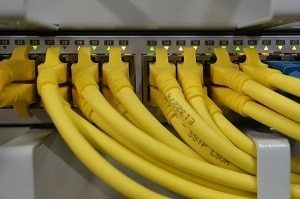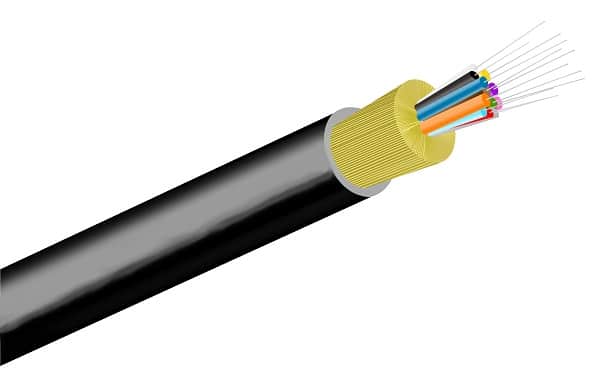How Much Does Fiber Optic Cable Cost?
Last Updated on March 3, 2024
Written by CPA Alec Pow | Content Reviewed by ![]() CFA Alexander Popinker
CFA Alexander Popinker
Fiber optic technology has revolutionized modern communications by enabling incredibly fast data transmission through light signals in glass fibers. As one of the backbones of the internet and telecommunications infrastructure, fiber optic networks provide almost unlimited bandwidth capacity and speeds.
However, deploying fiber optic cables requires significant upfront investment. Understanding the costs of fiber optic cable and installation is crucial for any project budgeting. This article will illuminate what goes into the pricing of fiber optics to help you plan and manage expenses.
We will break down the factors affecting the costs of the cables themselves, labor for installation and maintenance, additional materials needed, and strategies to control your budget.
Whether you are looking to install fiber optics at home, in a commercial building, or across towns—you need to estimate and compare the overall price tag realistically.
How Much Does Fiber Optic Cable Cost?
Fiber optic cables retail, on average, for a cost between $1 and $6 per foot for the cable alone. If you buy wholesale, then you can get fiber optic cable for $0.09 to $1.52 per foot. The type of fiber optic cable selected based on your requirements, length of installation, and number of fiber strands in the cable primarily determine its base price.
Honecable.com provides a range of wholesale fiber optic cable prices, which can vary from $0.3 to $4 per meter ($0.09 to $1.52 per foot).
Genuine Modules mentions that the cost of fiber optics per kilometer can range from $10,000 to $50,000, depending on various factors such as the type of fiber, installation method, terrain, and region.
Reddit features a discussion where a user shares a quote from Spectrum for $6,000 to run fiber optic cable up pre-existing poles for a distance of approximately 450 feet.
Amazon offers a 1000-foot bulk fiber optic cable for $0.57 per foot.
LANshack.com lists a 6-strand indoor plenum-rated multimode OM1 62.5/125 fiber optic cable by the foot, priced at $0.57.
Types of Fiber Optic Cables and Their Costs
Single-mode fiber cables are designed for long-distance, higher bandwidth applications using light signals of a single frequency. They have a higher upfront cost but allow connections across longer distances up to tens of kilometers. expect to pay around $2-$6 per foot for quality single-mode cables.
Multi-mode fiber cables use light signals of multiple frequencies and are suitable for shorter distances up to a few kilometers. Multi-mode cables cost comparatively less in the range of $1-$4 per foot depending on the specifications.
Whether the cable is intended for indoor or outdoor use also impacts the pricing. Outdoor cables have additional protective layers and resilience against outdoor elements. They are more expensive than basic indoor fiber optic cables.
Pricing by Length and Fiber Count
The total length of fiber optic cable needed directly drives the installation costs. Cabling for long-distance networks across towns is more expensive than short building-to-building connections.
Additionally, cables with higher fiber strand count cost more as well. For instance, a 1000-foot cable with 6 fiber strands will be cheaper than a 1000-foot cable with 24 strands. Evaluate your bandwidth requirements to choose an optimal fiber count.
Installation and Labor Costs
The installation of fiber optic cables requires skilled technicians and significant labor. Handling the glass fiber strands with precision is vital for optimal network performance.
Overview of Installation Processes and Expenses
Installing a fiber optic network entails detailed planning, cable laying, splicing, terminate connections, and testing.
Cable laying involves either underground trenching or aerial installation on utility poles. Permits, materials, specialized equipment, and restoration of sidewalks, driveways, etc. after trenching are major expenses.
Splicing and termination connect the individual fiber strands properly using delicate mechanical splicing, thermal fusing, or adhesive connectors. This requires extra tools, materials, and training.
Finally, the installer must test signal continuity and strength through the entire fiber optic cable run using specialized high-precision test equipment. Improper joining or testing can severely compromise network speeds and reliability.
Labor Rates and Factors Influencing Installation Cost
In general, you can expect to pay $100 to $150 per hour for certified and experienced fiber optic technicians. Simple interior wiring may fall in the lower range, while complex outdoor main-line installation will be over $125 per hour.
Also read our articles about the cost of laptop hinge repair, cable TV, and T1 internet connection.
The skill level required, distance covered, building construction challenges, and other site-specific factors affect the labor hours required and overall installation price. Get quotes from 3-4 vendors to compare rates.
Additional Costs in Fiber Optic Projects
Apart from the cables and direct installation services, additional components are needed to complete fiber optic network builds.
Equipment and Materials Needed for Installation
Fiber optic test equipment, splicing equipment, termination panels, connector types, distribution boxes, conduit, poles, and other materials add to the total project price. Having technicians provide their own tools and materials vs. sourcing separately changes cost calculations.
Ongoing Maintenance and Upgrade Expenses
Expect to budget 1-2% of the initial fiber optic installation cost per year for network maintenance. Emergency repairs, locating underground cable faults, replacing damaged cables etc. are common maintenance needs.
As your bandwidth needs grow, upgrading backend fiber optic components to higher speeds may be required. New active equipment to light up added fiber capacity also adds costs.
Strategies for Cost Management
 Careful planning and smart project management can yield significant cost savings in your fiber optic installation or network upgrade.
Careful planning and smart project management can yield significant cost savings in your fiber optic installation or network upgrade.
Tips for Reducing Overall Project Costs
- Research material and labor rates in your area for the most competitive quotes
- Leverage existing conduit access to minimize new trenching
- Use overhead aerial fiber runs rather than underground where feasible
- Size your fiber counts with upgrades in mind to avoid frequent retrofits
- Only engage certified technicians to minimize rework and errors
Financing and Budgeting for Fiber Optic Installation
- Check federal and local broadband subsidies for eligible partial funding
- Spread costs over time by owning only the fiber, while an ISP lights it up
- For community networks, share costs by allowing open access to providers
- Lease dark fiber to large bandwidth users to offset installation costs
Final Words
As we have explored, fiber optic cables themselves account for only around 30% of the total installation price. Labor, materials, equipment, and site conditions largely determine the overall cost of building and maintaining a high-speed fiber optic network.
Careful budgeting and working with qualified professionals ensures your investment delivers the future-proof connectivity you expect. Fiber optics remains the gold standard for speed, capacity and reliability. While the upfront cost seems high, it pays dividends for decades to come as our data needs continue growing exponentially.
Frequently Asked Questions
Is fiber cheaper than WIFI?
Fiber optic internet is generally cheaper than wireless internet in the long run. The initial installation cost of running fiber optic cables is high, but once in place fiber provides nearly unlimited bandwidth capacity at consistent speeds.
Wireless networks involve lower upfront equipment costs for routers and access points. However, bandwidth is shared and speeds degrade with more users and interference. Fiber optic networks can comfortably accommodate many simultaneous users at gigabit speeds. The operating costs work out to be lower per Mbps for well-designed fiber networks.
Is fiber optic cable worth it?
Installing fiber optic cabling offers future-proof connectivity that makes it worth the investment. Fiber can reliably deliver symmetrical gigabit internet speeds at large bandwidths.
This supports cutting-edge applications like 8K video streaming, massive cloud backups, real-time VR collaboration, and more. Fiber handles growth in users and bandwidth needs cost-effectively for decades.
The glass fiber strands are immune to electromagnetic interference that wireless networks struggle with. For individuals, businesses, and community networks that need unhindered data capacity, fiber optic internet is absolutely worth the higher initial cost.
What is the downside to fiber optic?
The main downside to fiber optic networks is the large upfront installation cost, especially burying cables over long distances. Outdoor fiber cables are also vulnerable to damage from digging or rodents, which can be costly to locate and repair.
Network equipment needs backup power to avoid service interruptions in case of electricity failures. Fiber internet is not inherently secure and still requires encryption protocols to prevent data tapping.
Despite the high initial pricing, none of these disadvantages outweigh the massive benefits of virtually unlimited bandwidth capacity and future-proof reliability.


Leave a Reply
Want to join the discussion?Feel free to contribute!